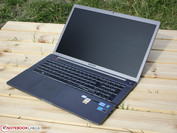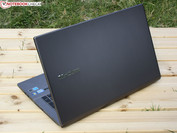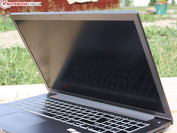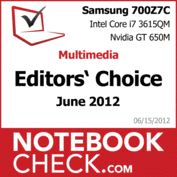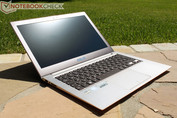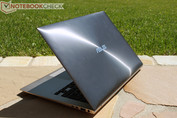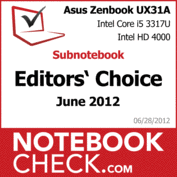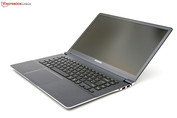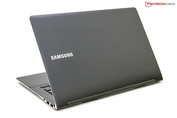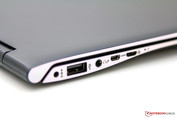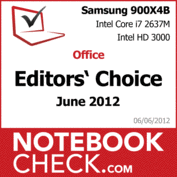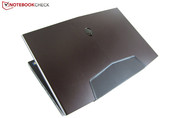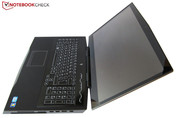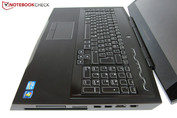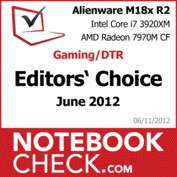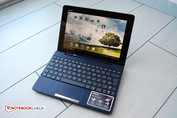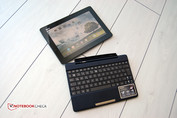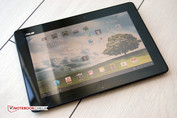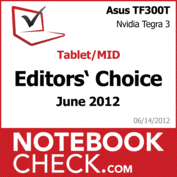Notebookcheck's Best of June 2012
It is no surprise that AMD is left in the shadows once again with very little to show. Nevertheless, 3 of the 25 devices came equipped with AMD chips. These are the U32U from Asus (E-450), HP's Pavilion g7 (A10-4600M) and HP's 4535s (A6-3400M). The HP Pavilion g7 is based on AMD's newest Trinity CPUs.
Samsung's Galaxy S3 smartphone was released to the masses and although it was impressive in our extensive test (88% - Very Good), it was not rewarded with an Editor Choice Award due to the lack of competitors.
Category: Multimedia
Contenders:
MSI GE60-i789W7H 79%
MSI GE70-i789W7H 80%
Samsung Series 7 Chronos 700Z7C 86%
MSI GE70-i547W7H 80%
In recent months, a (few) voices have been raised saying that Notebookcheck reviews only subnotebooks and gaming machines. Now, thanks to the availability of Intel's new CPUs, we can put the money where our mouth is in June. Seven multimedia all-rounders faced the jury and wanted to convince us with their qualities. Multimedia notebooks have an especially hard time in our evaluations as they have to manage the difficult balancing act between performance and mobility while being attractive and feature a good screen.
Both MSI devices, the GE60 and GE70, could score well in the performance stakes but the case quality was not as good. Asus' representatives did a better job here and also came with 15-inch (N56VZ) and 17-inch (N76VM) machines. Both devices managed a good overall score with convincing arguments in the sound, performance and screen criteria.
Game, set and match for Asus? Well almost, if it wasn't for Samsung's Chronos 700Z7C - an elegant and well-manufactured 17-inch multimedia machine. It not only impresses with Nvidia's GeForce GTX 650M and Intel's quad-core CPU when it comes to performance, but also features an excellent screen (bright, matte, good contrast) and even offers a feasible battery life of 4 to 5 hours. There were very few areas where the laptop fell short of our expectations and just missed out on a "Very Good" overall rating.
Multimedia notebook of June: Samsung Series 7 Chronos 700Z7C
Even if it was not quite enough for our highest rating, the Chronos 700Z7C did prevail against its rivals. Samsung offers a balanced package that meets the universal needs of many multimedia users and does not forget its roots as a portable computer while doing so. Both the battery life and the weight of three kilograms enable satisfactory mobility for a 17-incher.
What we like
Great sound, build quality and a contrast-rich Full-HD display. Good gaming performance, high computing power and always cool to touch during use.
What we'd like to see
An eSATA port and a better click-pad would make things perfect.
What surprises us
The 17.3-inch Series 5 550P7C struggles with the same throttling issues with its weak 90W power supply.
The competition
17-inchers featuring Full-HD for the personal desktop or as mobile XL communication HQ: Fujitsu's Lifebook NH751; Asus' N75SF-V2G-TZ117V; Dell's XPS 17-L702X; HP's Pavilion dv7-6b02eg; Schenker's XMG P701 PRO
17-incher without Full-HD: Acer's Aspire V3-771G; Aspire 7560G (Fusion); Aspire 7750G; Samsung's Series 5 550P7C-S02DE; Dell's Vostro 3750; HP's ProBook 4720s; Toshiba's Satellite Pro L770-116; Packard Bell's EasyNote LS11HR-167GE; Samsung's Series 3 305E7A-S03DE; Sony's Vaio VPC-EJ3D1E/W
Category: Subnotebook
Contenders:
Samsung Series 5 530U3C-A01DE 84%
Asus U32U-RX042V 81%
Dell Vostro 3360 84%
Lenovo ThinkPad X230 2306-2AU 89%
The differences could hardly be bigger, especially in Asus' camp. While the U32U tries to catch our attention with its attractive price of under EUR 500 (~$620), the Zenbook UX31A ultrabook claims the top position for itself with the moniker "Prime". We do have a saying that goes something like “Pride goeth before a fall”. But this is not so with Asus' Zenbook UX31A. An aluminum uni-body (ala Apple Macbook Air), SSD-ULV combo, a top class Full-HD IPS screen (that is matte!) and a battery runtime of roughly 5 hours in practical use makes the other competitors from the ultrabook division look like old hats.
Samsung's 530U ultrabook is hundreds of euros cheaper, but cannot hold a candle to the Asus in almost any of the feature categories. The actual adversary should be the Series 9 900X3C, which would make the competition a lot more interesting.
Back to the subnotebooks of June. Sony also tries to establish itself here and enters its Vaio SVT13 into the race. The price of well below EUR 1000 (~$1250) is again an appealing feature, to the chagrin of the screen and thermal management.
Dell's Vostro 3360 wants to continue the success story of affordable entry-level business devices, which is basically working quite well. We would have expected a bit more from the screen. A value less than 180 cd/m2 is not satisfactory, even for a mobile office companion.
Only one contender is left in this June group: The ThinkPad X230 from Lenovo. As one of the first mobile notebooks, the older X220 had a bright IPS screen with bright colors and excellent viewing angles. This was not the only feature that attracted a large customer base that became fans of this form factor. The development of this laptop has progressed with the new X230 and Lenovo has made the excellent decision to carry the screen to the new laptop. However, the Ivy Bridge hardware and the chiclet-style keyboard are new. The keyboard will be the bone of contention for many who are used to the excellent and iconic ThinkPad keyboard of the older X220.
Subnotebook of June: Asus Zenbook Prime UX31A
According to the score, the Zenbook has a slight lead on Lenovo's X230 that attracts a different customer group. The X230 is a significant pick due to its business-specific features (docking station, display port, security). Nevertheless, Asus' Zenbook UX31A delivers an almost perfect product for a subnotebook with a hint of business-readiness in the consumer range. Again, it is the wonderful screen that wows the crowd and makes it a “must-have”.
What we like
The Zenbook Prime UX31A is the next logical step to the UX31, where Asus does an almost perfect job improving the laptop.
What we'd like to see
Depending on the intended use, the lack of a display port, Gigabit LAN or the limited RAM could be listed as possible drawbacks.
What surprises us
How well you can work with the Full HD screen after a bit of adjustment with the screen resolution. Photoshop, Powerdirector and other graphic editors should be a breeze to work with due to the screen.
The competition
Depending on the requirements of the consumer, Asus' Zenbook Prime UX31A has either numerous or very few rivals. Dell's XPS 13 from the ultrabook league would be a contender. It is on a par with the UX31A in terms of looks and case quality, but cannot compete with its screen. Devices with a matte screen are still very rare. Fujitsu's U572 or Toshiba's Z830 or the new Z930 might be alternatives, but they only feature screens with HD resolution (1366 x 768).
Beyond that, Apple's new MacBook Air 13 (Mid 2012) could be seen as a contender, even if it is difficult to compare due to the different platform. Samsung's Series 9 900X3B or the new 900X4C which also features a matte screen with IPS quality, but "only" a resolution of 1600 x 900 pixels, would be significant choices for the consumer. The prices starts at EUR 1500 (~$1900) and comes with 8GB of RAM.
Category: Office
Contenders:
Lenovo ThinkPad Edge E530 (NZQBQGE) 83%
HP ProBook 4535s-A1F21EA 83%
Samsung Serie 9 900X4B-A01DE 86%
We also see vast price to performance differences in our June Office notebooks. Here, the focus is on offering outstanding qualities for the office, i.e. high-end and practical inputs, eye-friendly screens and not the least, good battery life since the user needs good workability on the go.
HP's g7 is a possible entry into this category. It comes with a 17.3 inch screen (glossy) and starts at around EUR 500 (~$625). However, cutbacks have clearly been made in case quality and connectivity. HP's ProBook range has superior build quality and business features. We reviewed the 4535s and its screen is not exactly brilliant either; but in comparison to the g7, the case and equipment provided is a lot better and the price is quite low thanks to AMD's Llano platform.
Among others, Lenovo offers the Edge E530, which also shows weaknesses in screen quality, and the laptop falls in the low-end business range. The performance is acceptable due to Intel's dual-core CPU and optional dedicated graphics, and even allows performing basic multimedia tasks on the device.
Again, Samsung's 900X4B is in a league of its own. The superior build quality and design with the latest in hardware make it a premium device for the business executive. Using Intel's ULV technology, it is able to achieve an extra-long battery runtime. The screen is matte, bright and features a good resolution of 1600 x 900 pixels. However, its contrast is not really convincing, but it is still acceptable for a device mostly used in the office.
Office Notebook of June: Samsung's Series 9 900X4B-A01DE
Business experts like the Latitudes, ThinkPads or Elitebooks which have a few advantages over the Samsung. However, the target group who prefer slim, high-end notebooks that exhibit excellent design and portability are going to like the Samsung. Dedicated business features are swapped in favor of higher mobility (low weight and long battery life). We like the high quality, decent choice of interfaces and the very good system performance despite having ULV components.
What we like
The new design, the aluminum unibody and the workmanship makes it an attractive device.
What we'd like to see
Above all, a higher quality screen with excellent measurements in our test. The screen's matte surface and the resolution are a good start. Also, we miss the HDMI and VGA adapter in the retail package.
What surprises us
That the cooling system has not been modified enough. We would have appreciated a quieter and efficient solution. Perhaps the Ivy Bridge update will come with new tidings.
The competition
Until now, only few 15 inch notebooks with a slim aluminum case have been available. One candidate is Acer's Aspire Timeline Ultra M3-581TG ultrabook. On the other hand, there are many 13.3 inch ultrabooks on the market. Asus' Zenbook UX32VD offers a first outlook at the upcoming devices featuring Intel's Ivy Bridge processors. And Apple has come out with a slim Macbook Pro that will reviewed very soon.
Category Gaming / DTR
Contenders:
Medion Erazer X7817 (MD 98058) 83%
Deviltech Fire DTX (MSI MS-16GA) 79%
Mobility? No, thanks. Every additional frame per second counts for gaming machines and unadulterated performance is needed for the best experience. Medion proves that performance does not inevitably have to be expensive with its Erazer X7817. The notebook fuses Intel's quad-core CPU and Nvidia's GTX 670M in a 17-inch case, alongside an SSD and the Killer WLAN module. It is priced around EUR 1500 (~$1900).
Deviltech's latest Fire DTX comes in at a slightly lower entry price, but also less raw power. Here, Nvidia's GTX 650M is used with Intel's quad-core CPU and a swift SSD to ensure fast responses to input. The great feature of the laptop is the excellent matte FHD screen with good brightness and contrast. The price is just as good and starts at a bit over EUR 1000 (~$1250).
We continue with another form factor where only one manufacturer sets the tone- Alienware. The M18x is a superlative gaming notebook in many ways. An 18.4 inch FHD screen, Intel's quad-core CPU, two high-end graphics cards (currently AMD's 7970M CF or Nvidia's GTX 680M SLI) and up to 4 storage expansion slots (3 x 2.5" bays and 1 x mSATA slot). Its performance? Beyond comparison. Just like the price. It starts at about EUR 2000 (~$2500), but configurations with up to EUR 5000 (~$7250) are no challenge to create.
Back to more reasonable and affordable offerings like Asus' G75VW. Although the notebook only offers one GPU and a "low performance" quad-core CPU, the overall bundle is pretty convincing. Like its predecessors, the laptop scores high with its low noise output, even while gaming. The FHD screen is matte and has good brightness and contrast. "Strike in silence" says Asus. We say: "Mission accomplished".
The last member of the DTR category in a group of one: Asus' A95VM. Average multimedia hardware meets a gigantic 18-inch screen. If you are not dependent on an oversized screen, you will surely find more interesting devices for around EUR 900 (~$1150), which Asus demands for its XXXL multimedia notebook.
Gaming notebook of June: Alienware M18x R2
In the end there can only be one and considering the tested devices, it is the Alienware M18x R2. We like how Dell approaches the matter of gaming and creates an adequate platform for the best and fastest mobile technology available on the market. The target groups are multimillionaires (not kidding), pro-gamers and those who want to buy their way into exclusive LAN parties.
What we like
Performance does not trail "real" gaming PCs
What we'd like to see
Will Alienware ever offer a decent non-reflective screen?
What surprises us
The ridiculous prices for upgrades
The competition
Strictly taken, among 18" units, there are no alternatives. At best, there is the Clevo bare bone model P180HM.
Category: Tablet / MID
Contenders:
Asus Transformer Pad TF300T 87%
Finally, a small group of tablets, which managed their way into our review center in the torrent of Ivy Bridge devices. We start with Samsung's Galaxy Tab 2. Our overall rating of 85% is adequate for a decent device. However we believe that the upgrade is too minor when compared to its predecessor.
Asus presents its low-end Transformer concept in form of the TF300T. It saves a few euros by using a plastic case, but provides enormous value with the docking keyboard in contrast to other tablets. Long typing sessions are no issue and the battery in the keyboard can also extend the tablet's runtime considerably. Over 10 hours of run time is quite possible in practical use.
Tablet of June: Asus Transformer Pad TF300T
Asus continues its successful notebook-hybrid concept for the third generation and appears to be willing to expand this even more in future with new devices. Asus presented a range of devices based on the same idea at this year's CES. We are curious about how close tablets will come to notebooks in the next few years.
What we like
The docking keyboard is a nice addition and helps extend the battery life. The display is very good.
What we'd like to see
A 3G module. This is available for a surcharge in other versions of this tablet.
What surprises us
Nothing really surprised us. The tablet is strikingly inconspicuous and that is good.
The competition
All recent tablets would be considered as competitors of the Asus Tablet. These include Motorola's Xoom 2, Apple's iPad 3, Acer's Iconia Tab A200, and Asus' Eee Pad Transformer Prime TF201.




